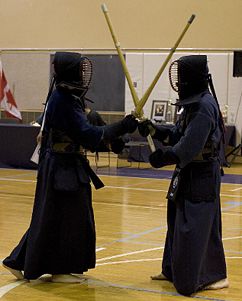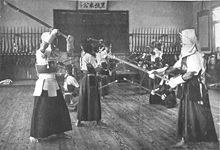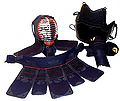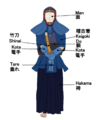Kendo
| Kendo | |
|---|---|

| |
| Japanese Name | |
| Japanese | 剣道 Kendō |
| Kana spelling | けんどう |
| Rōmaji (Hepburn) | Kendo |
| Kunrei-shiki | Kendo |
| Nihon-shiki | Kendo |
"Kendo" (剣道 Kendō) , is the martial art of Japanese fencing, developed from traditional techniques of Japanese swordsmanship known as "kenjutsu." Since 1975 the goal of Kendo has been stated by the All Japan Kendo Federation as "to discipline the human character through the application of the principles of the "katana" (the Japanese standard two-handed sword)." Kendo combines the values of martial arts with elements of sport; some practitioners stress the values while others concentrate on the sport.
Taught using "swords" made of split bamboo ("shinai") and extensive protective armour ("Bogu"), practitioners are called "kendoka," meaning one who practices Kendo, or "kenshi," signifying a swordsman. Kendoka also use "bokuto" (wooden katana) to practice set forms known as kata. On formal occasions, real swords or metal swords with a blunt edge, called habiki, can be used. There are 8 basic Scoring Regions.
Swords
The sword holds a very significant place in Japanese history. The proof of the authenticity of the Emperor has been the transfer of Three Sacred Treasures which serve as the Imperial Regalia. One of these Treasures is the special sword named Kusanagi which was found by the brother of Amaterasu (the Sun Goddess), Susanoo, in the tail of an eight-headed serpent he had just slain, Yamata no Orochi. The tenth Emperor Sujin deposited the Three Sacred Treasures in a shrine dedicated to Amaterasu. In 4 c. e. the Three Sacred Treasures were transferred to Uji in Ise Province. In 113 C.E., as Prince Yamato Takeru passed through Ise on his way to the northern part of Japan to subjugate the Ainu, he stopped to worship at the Ise Shrine and his aunt, Yamato-hime, loaned him the sword and a bag for his protection. When the Ainu attacked his troops by setting wildfires in a field, he opened the bag which his aunt gave him and found a flint. He cut the grasses around him using the sacred sword, and used the flint to set reverse fires which swept through the enemy ranks.
Swordsmith
The "katanakaji" (swordsmith) belonged to the top of a highly respected social class of specialized artisans and artists, and such practices continue through the present age. Swordsmiths prepare for the swordsmithing process by calling on a guardian god. To invite a god to the workshop, the swordsmith surrounds the area with consecrated ropes, dispelling evil spirits, while conducting special rites in ceremonial dress. As they struck the iron bar and bathed it in fire and water, the swordsmiths put their heart and soul into their work, praying to receiving help from the god. The sword produced through these zealous efforts was a highly refined art form.
The most renowned of the "katanakaji" was Masamune who worked during the early –to- mid 1300s (at the end of the Kamakura era). His works are considered to be so superior that they continue to be sought after by collectors today. Masamune has been compared with Muramasa, another legendary swordsmith and the ablest disciple of Masamune. Legends regarding Masamune and Muramasa include a story that one day someone tested the sharpness of a sword made by Muramasa by standing it in the lower reaches of a stream and floating several dead leaves down the stream. Each floating leaf was cut in half as it drifted against the blade of Muramasa’s sword. Then he replaced Muramasa’s sword with one of Masamune’s. Amazingly, the leaves floating down the stream avoided Masamune’s sword blade entirely. The Masamune was more than a cutting implement; it was divinely inspired, while the Muramasa sword was simply an instrument of destruction and nothing more.
Zen and Kendo
A scene in Akira Kurosawa’s famous film,“The Seven Samurai, ”is based on an authentic account of a samurai who rescued a baby. During the Civil Wars in Japan, a village of farmers, who are inexperienced in battle, hire seven samurai to protect them from a band of marauding robbers. One day a robber kidnaps the baby of a villager and holds the baby hostage in a farmer’s cottage. A passing samurai quickly shaves his head and changes his clothes for a monk’s robes. He approaches the cottage as a monk and distracts the robber by offering him a rice ball, then snatches the baby to safety. That samurai was Kamiizumi Nobutuna or Kamiizumi Isenokami (1508-1577 c. e ), the founder of the Shinkage-ryu (school). Shinkage-ryu was the most popular school of swordsmanship school during the Japanese feudal samurai era. Kamiizumi’s Shinkage-ryu trained many supreme sword fighters and created the main Kendo tradition. Kamiizumi’s disciple, Yagyu Muneyoshi, became one of the most famous master swordsmen, and the Yagyu family became the official instructors of Kendo for the Tokugawa shoguns.
When Kamiizumi certified that a swordsman had reached the highest level of proficiency, he handed him a piece of paper on which there was no writing, only a circle. This signified that the swordman’s mind must be kept free from selfish and intellectual preoccupations, a Zen Buddhist state of enlightenment. Technical skill alone did not qualify a swordsman for the highest level of proficiency and the status of a master of the school. Around this period Takuan Soho, a powerful Rinzai Zen monk, had a strong influence on Japanese swordsmanship and calligraphy. His strong character caused him to be exiled for a time. The Tokugawa Shogun Iemitsu forgave Takuan and made him a political adviser. Takuan wrote letters to Yagyu Tajima no Kami Munenori (son of Yagyu Muneyoshi) explaining not only the mastery of true swordsmanship, but also the basic significance of Zen Buddhism. The art of swordsmanship required more than the mastery of technique. Yagyu Tagima no Kami learned from Takuan that the stage of “the mind that is no-mind” (''mushin no shin'') is the ultimate enlightenment in the art of swordplay.
A beginner is eager to learn as much as possible about the techniques of wielding a sword. However, if he concentrates only on doing well, or on showing his skill or his supremacy over others, he will meet with failure because his ego becomes an obstacle to progress. When performing in a state of “no-mind” (''mushin''), which means the elimination of all consciousness of self, the swordsman is perfectly free from inhibitions.
History
Kendo, "The Way of The Sword", embodies the essence of the Japanese fighting arts. Since the earliest samurai government in Japan, during the Kamakura period (1185-1233), sword fencing, together with horse riding and archery, were the main martial pursuits of the military clans. During this period Kendo developed under the strong influence of Zen Buddhism. The samurai could equate disregard for his own life in the heat of battle, which was considered necessary for victory in individual combat, to the Buddhist concept of the illusory nature of the distinction between life and death.
Since that time many warriors have become enlightened through the practice of Kendo. Those swordsmen established schools of Kendo training which continued for centuries, and which form the basis of Kendo practice today. The names of the schools reflect the essence of the originator’s enlightenment. Thus the Itto-Ryu (Single sword school) indicates the founder’s illumination that all possible cuts with the sword emanate from and are contained in one original essential cut. The Muto (swordless school) expresses the comprehension of the originator Yamaoka Tesshu, that "There is no sword outside the mind." The Munen Muso Ryu (No intent, No preconception) similarly expresses the understanding that the essence of Kendo transcends the reflective thought process.
The formal Kendo exercises set down sometime several centuries ago are studied today using wooden swords in set forms, or 'kata.' The present form of using "shinai" and "bogu" was begun in the 18th century by Naganuma Sirozaemon Kunisato (長沼四郎左衛門国郷 1688-1767). Training using bamboo practice swords and substantial armor includes both formal exercises and free fencing. Today it is still possible to embark on the quest for spiritual enlightenment in the same manner as the samurai of old. Concepts such as 'Mushin', or 'empty mind' as professed by exponents of Zen are an essential attainment for high level Kendo. Fudoshin, or 'Unmoving Mind', a conceptual attribute of the deity Fudo Myo-O, one of the five 'Kings of Light' of Shingon Buddhism, implies that the fencer cannot be led astray by delusions of anger, doubt, fear, or surprise arising from his opponent’s actions.
In 1920, Dai Nippon Butoku Kai (大日本武徳会, developer of the Japan Martial Arts Foundation) changed the name of Gekiken (撃剣, "hitting sword") to Kendo.
Modern Kendo
In modern Kendo, there are two types of attacks: strikes and thrusts. Strikes are allowed against only certain areas on the body, datotsu bui. The valid targets are men (top of the opponent's head), sayu-men or "yoko-men"(the left and right side of the opponent's head), right kote, or wrist at any time, the left kote when it is in a raised position (such as jodan), the left or right do (in tournament situations points are rarely awarded for striking the left side of the opponent's do). Thrusts are only allowed to the throat (tsuki). However, since a wrongly done thrust could injure the neck, thrust techniques are often left out at the starting level and practiced at later levels.
- Wikikendo2.JPG
Nihon Kendo Kata.
- Kendo EM 2005 - taiatari.jpg
Two kendoka in tsuba zeriai.
In matches, a point is only awarded when the attack is done firmly and properly to any of the allowed targets with Ki-ken-tai-ichi, or spirit, sword, and body united as one, as well as with "Zanshin" or continuation of awareness. For an attack to be successful the shinai must strike a proper target at the same moment that the attacker's front foot makes contact with the ground and the kiai(shout that displays good spirit) is shouted. Though it is common, especially in matches within a dojo, kiai need not be the name of the target that is being struck.
In a tournament, there are three judges (shinpan), each holds a red and a white flag in opposing hands. Each competitor has either a white or red ribbon attached to his or her back. For a point to be awarded, a minimum of two judges must agree. To signal this, the judges raise the corresponding coloured flag of the player who scored the point. The first to score two points wins the match. If the time limit runs out before two points are awarded, several things may happen: If one player has one point and the other does not, then the player with one point wins. In cases of a tie, the match may be declared a draw or decided by a period of overtime, sudden death overtime (the first to score a point wins regardless of time left), or a hantei, or judges' decision.
The International Kendo Federation (IKF) has members in 45 countries. International championships have been held every three years since 1970, when the IKF was founded.
Kata
There are 10 Kata which are performed with either a wooden sword (bokken/bokuto) or, occasionally, with a blunt-edged sword. Kata 1~7 are performed with both partners using a bokken of around 102 cm.. Kata 8~10 are performed with one partner using a bokken and the other using a kodachi of around 55cm. During kata, the two participants take the roles of uchidachi (teacher, this side always is the 'losing' side in kata) and shidachi (student, this is the 'winning' side).
Ranking
Technical achievement in Kendo is measured by advancement in grade, rank or level. The "kyu" and "dan" system is used to assess the level of ones skill in Kendo. The dan levels are from 1-dan (sho-dan) to 10-dan (ju-dan). 1-dan is equivalent to a first degree black belt. 1-dan (sho-dan) to 8-dan (hachi-dan) are awarded after a physical test and submitting an examination paper. There is no physical test for 9-dan (kyu-dan) and 10-dan (ju-dan), those levels are awarded by a special committee set up for the purpose. Additionally there are seven ranks below dan known as kyu. The number preceding the kyu is the number of ranks it is below the first dan rank (sho-dan). In Kendo there is no external sign of rank, meaning that an expert may be dressed just like a beginner.
Kendo in Other Countries
The International Kendo Federation (IKF) was established in 1970 and was composed of 44 countries/regions as of March 2006. World Championships are held every three years.
Asia
- Korea (Kumdo)
Africa
Only South Africa participates in the IKF. The South African Kendo Federation is the official body not only of Kendo but also Iaido and Jodo.
Australia
The Australian Kendo Renmei grew from the beginning of Kendo in Australia in the 1960's and is a founding member of the IKF. Annual Australian Kendo Championships have been held in Australia for over 30 years.
North America
South America
Europe
European championships of Kendo have been held since 1974 and are organized every two years. The first one took place in England. Kendo has enjoyed increasing popularity in Europe since then. European Kendo Federation, which also promotes Jodo and Iaido. Thirty-two countries/regions belong to it.
- France:After the end of World War II, many masters of Kendo came to France and introduced Kendo. France started playing Kendo in the 1950. The first championship was held in 1959.
- Germany:Kendo was introduced in the mid sixties as a part of Judo practice.
- Italy:Kendo is promoted by the C.I.K., Confederazione Italiana Kendo.
ReferencesISBN links support NWE through referral fees
- Donohue, John J.. Complete Kendo. Tuttle Publishing, 1999
- Ozawa, Hiroshi; Yamaguchi, Tamiko; Turzynski, Angela. Kendo: The Definitive Guide
Kodansha International, 1997
- Sasamori, Junzo; Warner, Gordon. This Is Kendo: The Art of Japanese Fencing,
Tuttle Publishing, 1989.
See also
- Japan
- Samurai - Japanese warrior
- Bushido - The way of Samurai - Japanese spirit
- Iaido
- Battōjutsu
- Budo
- Gendai budo
- Koryu
- Martial arts
- Stick fighting
- Fencing
- Kyudo
- Naginata-do
- Kirikaeshi
- Swordsman - some famous Japanese swordsmen are listed.
External links
- All Japan Kendo Federation
- International Kendo Federation
- Argentine Kendo Federation
- Australian Kendo Federation
- All Belgium Kendo Federation
- The British Kendo Association
- The British Kendo Renmei (Eikoku Kendo Renmei)
- The Kendo Federation of Brunei Darussalam
- Bulgarian Kendo Federation
- The Finnish Kendo Association
- The Canadian Kendo Federation
- European Kendo Federation
- French Kendo Federation
- Latvian Kendo Federation
- Polish Kendo Federation
- The New Zealand Kendo Federation
- Russian Kendo Federation
- All United States Kendo Federation
- Kendo Section of the Swedish Budo Federation
- Singapore Kendo Club
Credits
New World Encyclopedia writers and editors rewrote and completed the Wikipedia article in accordance with New World Encyclopedia standards. This article abides by terms of the Creative Commons CC-by-sa 3.0 License (CC-by-sa), which may be used and disseminated with proper attribution. Credit is due under the terms of this license that can reference both the New World Encyclopedia contributors and the selfless volunteer contributors of the Wikimedia Foundation. To cite this article click here for a list of acceptable citing formats.The history of earlier contributions by wikipedians is accessible to researchers here:
The history of this article since it was imported to New World Encyclopedia:
Note: Some restrictions may apply to use of individual images which are separately licensed.







